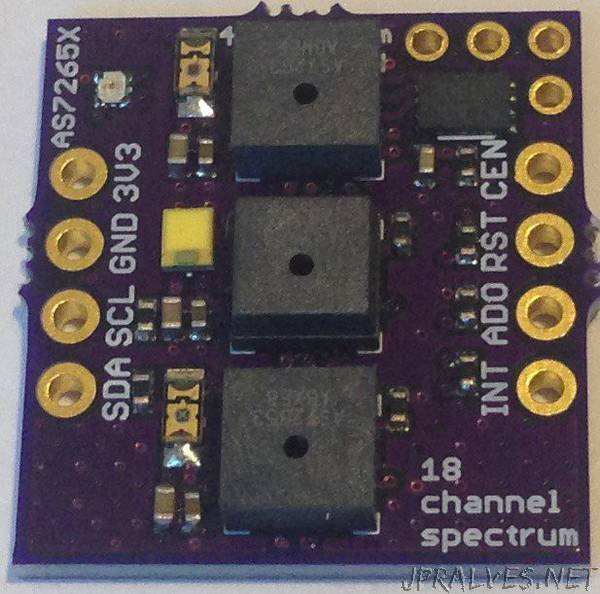
“AMS’s new AS7265X 3-chip set promises a compact, 18-channel, 20 nm FWMH spectrometer for less than $25
Designing and building an inexpensive spectrometer just got easier with AMS’ new 3-chip AS7265X smart spectral sensor; once this is working, building a modern tricorder should be a piece of cake!
DETAILS
AMS makes several interesting sensors including the CCS811 air quality sensor which I use in my STM32 Sensor Tile project and the AS7262 6-channel light sensor, which appears now in a breakout board that Adafruit has just announced. The AS7262 offers six channels in the visible (430 to 670 nm) with 40 nm FWHM resolution. There is also another similar AMS sensor the AS7263 which offers six channels in the near IR (600 - 870 nm) with 20 nm FWHM resolution.
I was thinking of designing a simple spectrometer out of these two by combining them onto one pcb. The problem with this idea is that they both have the same I2C address, so I would have had to use an I2C multiplexer. Then there is the problem of syncing the data conversion and read times to build a proper 12-channel spectrum. These are both manageable problems and I was looking forward to working them out when I discovered, in a way, AMS had already beat me to this idea.
It should be no suprise that AMS thought of combining sensors with different filters (this is how they achieve the relatively narrow 20 nm spectral resolution) just as I did. But they did it right, equiping one of the sensors with a master I2C bus to allow management and proper syncing with the other two. Yes, that’s right, in the 3-chip AS7265X set AMS has come up with (AS72651 as master, AS72652 and AS72653 as slaves) there are now 18 individual channels spanning the 410 to 940 nm range with 20 nm FWHM resolution. The full 18 channels can be read out after two conversion cycles (minimum conversion time is 5.6 milliseconds). The sensors can also control indicator leds as well as source leds for illumination to match the spectral response of the sensors.
The idea here is that the resultant device is a reflectance spectrometer which will work best when the object under analysis is bathed in light matched to the sensitivity of the (filtered) photodetectors. The chemical makeup of the test object will determine how much of the light is reflected or absorbed, and a catalog of specific spectral responses of known materials can be built up to allow identification of many unknown ones.
In the initial design, I have chosen one broad spectrum 5700 K 90 CRI led and two IR leds (one peaked at 850 nm and one peaked at 940 nm). The idea is to gather an 18-channel spectrum using the broad band illumination, then again using one or both IR sources. The latter will provide the signatures needed to distinguish and identify organic compounds and analyze plant and animal matter, whether in the wild, in the garden, or on the dining table.
The pcb itself has been designed to be as compact (18 x 19 mm) as possible while remaining easy to assemble, aesthetically pleasing, and functional.”
